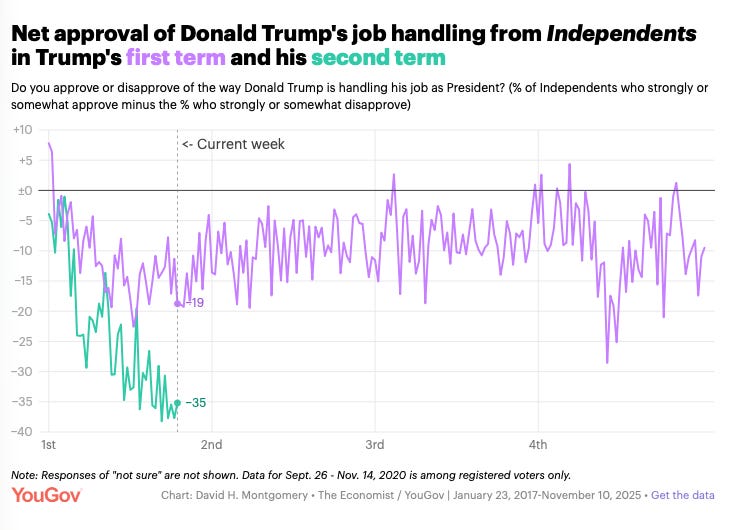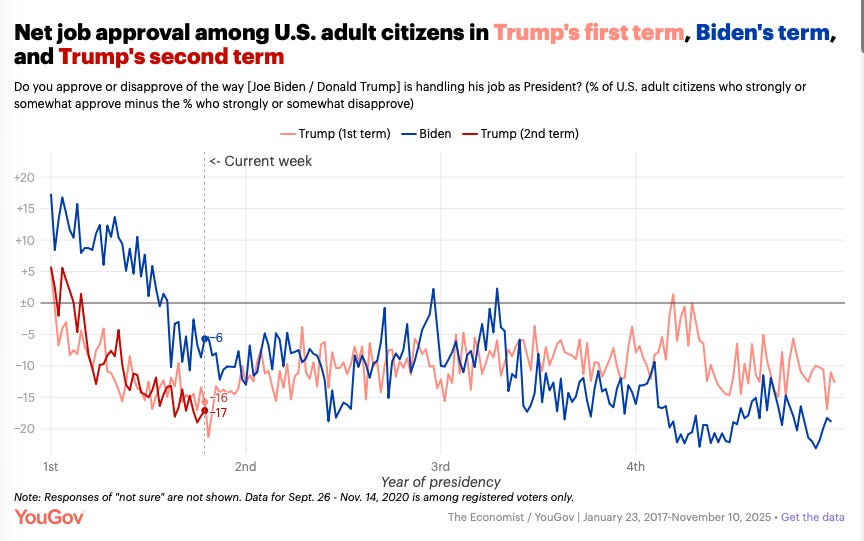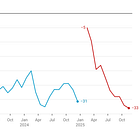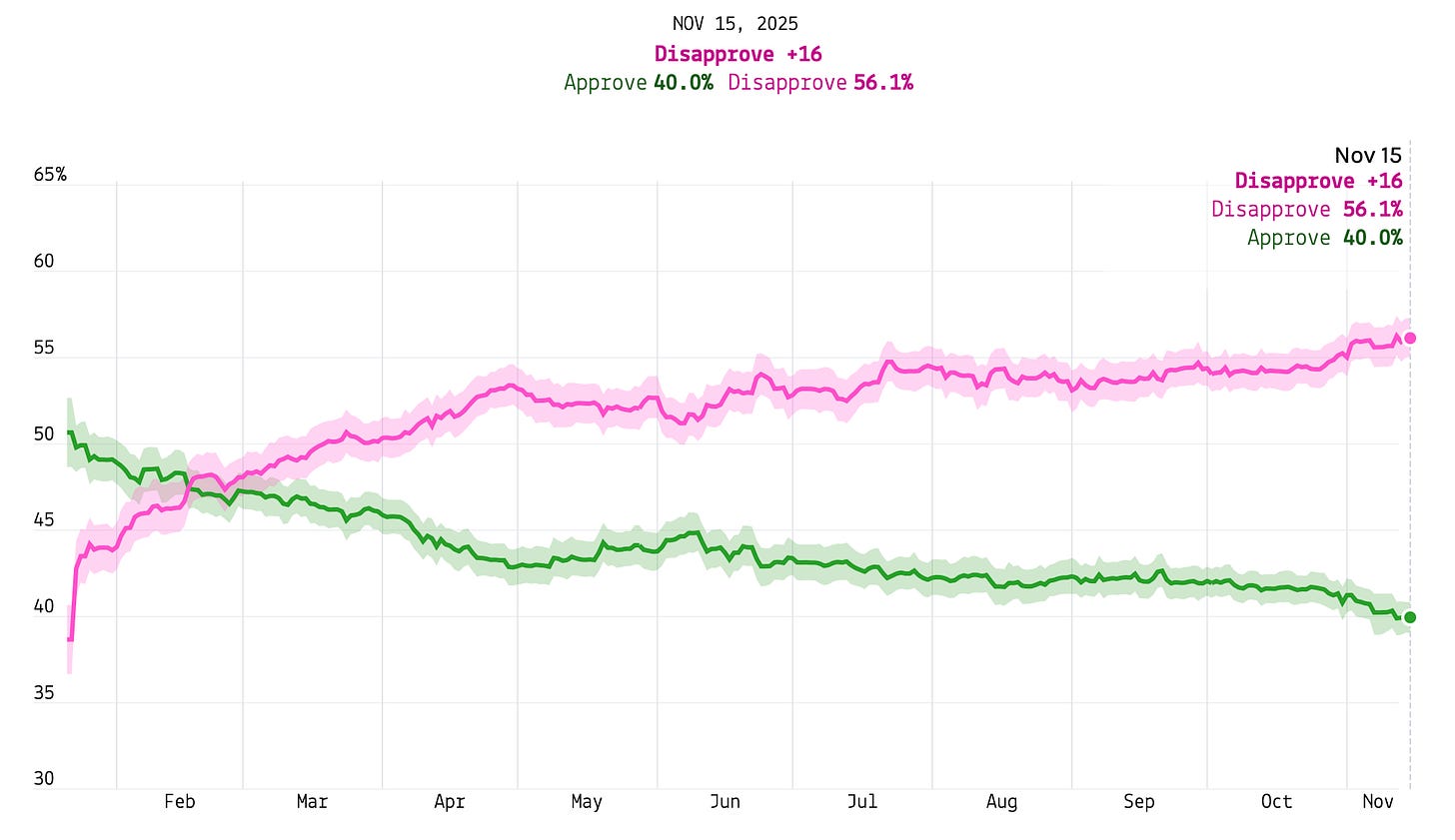Trump hits a record low with political independents — in every state
Your weekly political data roundup for November 16, 2025
Dear readers,
First, I want to express my deep thanks to everyone who reads and supports Strength In Numbers. This week, several high-profile analysts and partisan pollsters engaged in extensive ad hominem attacks against me and even questioned my motivation for publishing this newsletter. This is all because I am coming to data-driven conclusions that expose errors in their theories of how politics works, or that otherwise conflict with their own narratives about politics and elections today.
Critics can say whatever they want. I say: Let’s stick to an empirical discussion of the data and the merits of various methods (ours are open-source, nobody else’s are) we can use to understand numbers and the world around us. I have no interest in getting involved in pointless schoolyard fights on social media.
My mission with this publication is to produce independent, empirical analysis of politics and voting behavior — and I will continue to do that job regardless of who it pisses off or the hit my reputation takes among the elite-contrarian-consultant industrial complex. The loudest critics of my work are the people who have the most to lose from there being a popular, independent alternative on the market. The pushback I’m getting is proof that there is a need for high-quality empirical political analysis that is independent of the monetary and groupthink incentives that drive so much of the media’s analysis today.
So, thank you for supporting me and this publication. My work is funded by you, my readers, and accountable to the facts, not billionaire donors or Super PACs paying me for my conclusions. A diverse group of paying subscribers — devoted to the idea that rigorous analysis of data can uncover more truths about the world than punditry and partisan spin — makes factual independent journalism and analysis possible. You can continue to rely on Strength In Numbers for high-quality journalism regardless of what the bullies, partisans, and wealthy and well-connected say about me.
Now, for this week’s data roundup: The lead story is Trump’s rising unpopularity with swing voters, nationally and in key states. New YouGov polling shows an all-time low for the president among political independents. Should Republican Senators in purple seats be worried?
On deck here at Strength In Numbers: This week, I’ll share the results of our post-election survey with Verasight — including the normal poll write-up, plus an exclusive article on a new method for identifying what Americans want the parties to run on and stand for.
1. YouGov finds Trump at record low with independents
David Montgomery over at YouGov published the following chart of Trump’s approval rating among independents this week. The data is from the weekly polls YouGov conducts on behalf of The Economist (data which is becoming key to comparing Trump’s position with voters in his second term to similar data from his first term):
This chart is this week’s lead story because it shows how unprecedented a position Trump is in with the voters who are most likely to determine the outcome of close elections. While Trump is roughly as unpopular overall as he was at this point in his first term (see below) the difference in his support with marginal voters is potentially consequential for next year’s midterms — and 2028 after that.
The new data comes as Democrats are hitting new highs in the race for Congress next year. In YouGov’s new poll, the generic ballot is D+7 — close to the 8-point margin the party had at this point in YouGov/The Economist’s polling for the 2018 midterms. The average generic ballot poll is still not quite as rosy for Democrats, but the trend is currently their friend.
As the result of the 2025 elections suggest, Republican Senators will want to make the 2026 midterms about anything other than Donald Trump and his negative impacts on prices and affordability. Polls confirm this strategy. In the chart below, I show estimates from a MRP model of my Strength In Numbers/Verasight polling data that takes a national poll and transforms it into estimates of state-level opinion. The chart shows Trump’s net job approval at the state level, broken down by political party (ignore the outliers, which are likely due to sampling error):
Take note of two things: First, more independents in every single state say they disapprove than approve of how Trump is handling his job as president. And the margin is not even close, at roughly -35 in the average state.
Second, note that my estimated net approval among independents in the average state is close to YouGov’s national estimate of net approval among independents (-35). This provides some external validation of my estimates.
Based on this data, if I’m a Republican Senator up for re-election in 2026 (looking at you, Susan Collins), I’m looking for every opportunity available to distance myself from Trump. Maybe, for example, that means voting against him and in favor of the release of the government’s “Epstein files.” Politico reports that GOP leaders expect mass defections from the party line (up to 100 members or more) on the vote next week.
More to come on both of these subjects — independents and state-level opinion — with the release of our latest Strength In Numbers/Verasight poll this week.
2. What you missed at Strength In Numbers
Here’s everything published at this newsletter over the last week:
First up, my Friday column on how the Democrats can use the shutdown deal to potentially persuade voters about their commitment to the working class:
A long essay, published Wednesday, arguing you should quit social media (or, if you can’t quit because of your job or some other real, not-bullshit reason, then why you should at least dramatically scale back your presence on algorithmic platforms):
An extra post published for premium subscribers on Tuesday arguing that when it comes to his position on the economy, Donald Trump is Joe Biden now:
And, finally, last week’s Sunday data roundup:
As you’re thinking about the media diet you want to foster for next year’s midterms, consider a paid subscription to this Substack. Members get extra premium posts at least once a week (and, lately, more like 2-3x a week), an early look at any data products I’m developing, access to a private Discord server just for paid members, and more. (As recent events show, this is one of the few places you’ll get data-driven insights even when they conflict with the talking points chattering class.)
Paying members also support all the work that goes on behind the scenes to put together the SIN/Verasight poll, my state and congressional district MRP models, the coming Cost of Ruling Index, and all the other analyses that power my journalism.
3. Even more numbers!
Links to other articles in the political data space I discovered over the last week
I talk with Mary Radcliffe to former 538-er Geoffrey Skelley about our polling averages at FiftyPlusOne.news on the new DecisionDeskHQ podcast.
Blueprint research asks: Authoritarian, Just Unpopular, or Both? Trump’s Actions Under a Microscope
A couple of pieces about how Mamdani brought a lot of new and young voters into the electorate this fall. I reported on this last week, too.
Some inside reporting about how Trump has lost ground with Latinos, who were key to his (not-a-realignment) victory in 2024
Steve Rattner on how voters aren’t buying Trump’s excuses on affordability, with data from several new polls and how they compare to similar numbers in Trump’s first term
More YouGov data, this time on the Democratic primary for 2028 (I know, I know): Democrats have no standard bearer
This great article from The Downballot looks and new data from YouGov Blue that shows how polls can get different results on the generic congressional ballot — in this case, by reminding voters who is currently in charge.
This is yet another reflection of how the electorate’s current anti-incumbent bias shapes polls and election outcomes.
The Wall Street Journal looks at who is mentioned in last week’s big release of emails sent by Jeffrey Epstein over the decade leading up to this death. (Trump is mentioned a lot more than anyone else)
And these maps and chart show the undoing of Trump’s gains with Latinos in New Jersey, at the very granular township level:
4. Polling update
The Strength In Numbers polling averages have moved to a new webpage at fiftyplusone.news, a website purely for poll-tracking that I’ve set up with my friends. Some averages, like my average of Trump’s approval rating on individual issues, remain on the data portal but will be moved to the new site soon.
Trump’s net job approval is -16.1, a new low for the president.
The generic ballot is D+3.8, a new high for the Democrats.
That’s it for your major political data stories this week.
Got more for next week? Email your links or add to the comments below!
Have a nice week,
Elliott














I don’t know why Nate Silver is attacking you. He used to be a great analyst until he became that which he had always despised, a pundit. Now you’re the best data analyst around.
I took your advice to get off social media, so maybe I missed the attacks on you. I likely wouldn't pay attention to it anyway since I appreciate your solid analysis backed up by transparent data. I've given at least one gift subscription and suggested to several other friends that they become subscribers. That's the biggest compliment I can give. I especially enjoy the fact that you are respectful to and of your readers, and that you're committed to following "the numbers" wherever they lead--even if it's contrary to your initial reaction--as in the case of some Ds voting to end the government shutdown. You weren't afraid to say, "that's terrible. . .but wait, the actual numbers show there might be some political silver linings for Ds." Appreciate that honesty and integrity.